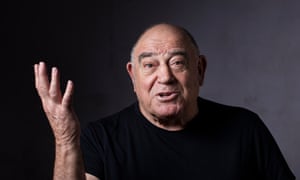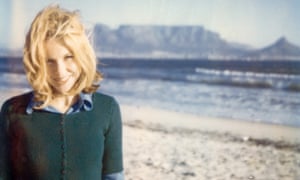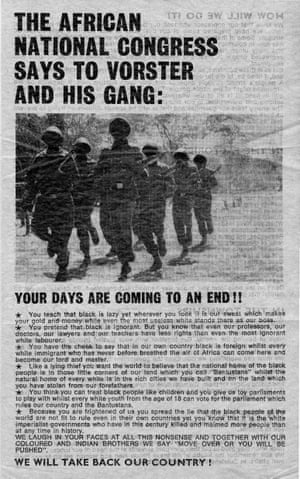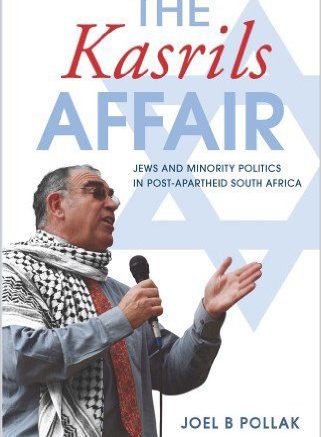In the 60s and 70s, Ronnie Kasrils recruited young white men and women in Britain and sent them to South Africa to detonate bombs filled with pro-ANC leaflets. He reflects on the success of his secret war

One day on Hampstead Heath in London nearly 50 years ago, Ronnie Kasrils nearly blew himself up. The freedom fighter, who would go on to become a minister in Nelson Mandela’s first government, was testing out an initiative in the secret war against white rule in South Africa – a home-made bomb combining gunpowder and a bucket holding hundreds of anti-apartheid leaflets.
“It required quite a lot of technology to get a rocket with 500 leaflets 20 metres into the sky,” Kasrils, now 77, recalls. “We used to go to parks in London at quiet times to experiment. One day, one went off course and came straight towards us. We dived behind a tree. Otherwise I wouldn’t be talking to you now.”
By “we”, he means a small group of exiled South African men and women operating from a flat over a shop in Golders Green in north London and a room in Goodge Street. They had been sent to Britain in 1965 by African National Congress (ANC) leader Oliver Tambo, tasked with producing propaganda showing that the fight against apartheid wasn’t over. At the time, the ANC appeared to be crushed – it was banned in South Africa, Nelson Mandela and other leaders were in jail, Tambo was in exile in Zambia, and its underground seemed to have been wiped out. “We needed to show the oppressed of South Africa that we were still in business,” says Kasrils.
To do so, he attempted to do something that has remained a secret for the best part of four decades – recruit white men and women in Britain to go to South Africa and set off bombs. “Apartheid, like any racist doctrine, presumed that all white people were natural allies. Hence suspicion was very low with regard to ‘caucasian’ visitors from abroad,” Kasrils explains. His idea was that young men and women would travel to South Africa pretending to be honeymooners, business trippers and tourists. They would explode homemade leaflet bombs, unfurl banners, and play rousing speeches to large crowds from improvised sound systems.

After the 1960 Sharpeville massacre, in which police shot dead 69 black South Africans demonstrating against pass laws and injured a further 180, public consciousness around the world about the evil of apartheid increased – and some decided to take action. “We needed people who were serious and aware of the risks of being jailed and tortured. Often, our recruits were not student intellectuals, but ordinary working-class people disgusted at apartheid and brave enough to do something about it.”
As a communist and co-founder of the ANC’s military wing, Umkhonto we Sizwe (Zulu for “spear of the nation”), Kasrils was well placed to recruit and instruct such volunteers. He had trained in the Soviet Union in guerrilla tactics and counter-surveillance techniques. “I’d also read John le Carré and learned a lot about tradecraft from him that we used in the field.”
Why did Kasrils, a white man of Jewish ancestry, choose to join the fight? “I hated racism at school. I had a history teacher who taught us about the French revolution, about liberté, egalité and fraternité. He emphasised the fraternité, I remember. I was inspired by that – the idea of true love of others no matter about national or religious barriers. But it was Sharpeville that radicalised me. I knew I had to do something.”
So, in London, he sought out potential recruits. He enrolled at the London School of Economics and met young communists, Trotskyists, anti-Vietnam-war activists and campaigners against British rugby and cricket teams touring South Africa. “I often met potential recruits in pubs or parks. I would arrive early to make sure they weren’t being followed.”

Those he chose would be taken to London parks to receive training in bomb assembly. “It was simple, schoolboy stuff, only took an hour.” He would also tell them that they should not socialise with black South Africans so as not to arouse suspicion. “They were mostly naive young people who hadn’t travelled, so I needed to tell them simple things, like not to join non-white queues in the post office because that would attract police attention.”
Each year between 1967 and 1971, Kasrils deployed two-person teams of London recruits to detonate leaflet bombs simultaneously in five South African cities. The leaflets that rained over Durban, Johannesburg, Port Elizabeth, Cape Town and East London contained defiant messages such as: “The ANC says to Vorster [BJ Vorster, South Africa’s prime minister from 1966-78] and his gang: Your days are coming to an end … We will take back our country!”
As the buckets exploded in strategic commuter sites, cassette recorders – placed in abandoned cars or bicycle baskets and wired to amplifiers – played messages recorded in London, beginning “This is the voice of the ANC” and including songs by the ANC London choir. Recruits unfurled banners from apartheid landmarks, signalling that the struggle for freedom was very much alive.
The result of all this was superb propaganda for the ANC. Kasrils was pleased in particular by an editorial in the Guardian the day after leaflet bombs exploded simultaneously in South African cities in the early 70s. “It said that despite claims that the underground in South Africa was smashed, it clearly spoke yesterday. It was exactly what we wanted to achieve.”
Were there casualties? “No. I remember there was one photograph that made all the front pages showing the moment a policeman tried to de-activate one bomb which went off. He wasn’t hurt but his uniform was blackened.”
The decision not to kill was deliberate. Recruits would scatter joke-shop tarantulas near the buckets to deter passersby from approaching them before they exploded. “We could have put nails and sharp metal in them,” says Kasrils. “We didn’t and that enabled us to have the moral high ground. We made people realise we weren’t out to kill them because they were white. It paid off in the end.”
The missions were mostly successful, but could easily have gone wrong. In a hotel room in Durban in August 1971, two recruits, Young Communist League memberGraeme Whyte and Denis Walshe, an electrician from Kent, were assembling a leaflet bomb. The room was filled with 10,000 ANC leaflets they had smuggled from London in a false-bottomed suitcase, timing devices, electric cables and small bits of explosives, and the air reeked of solder. “To my horror,” recalled Whyte: “I heard a key in the lock, the door opened and in walked one of the hotel staff.” He was terrified the black maid would inform on them. “I considered threatening her. Maybe a white man threatening to kill her would scare her no matter who she thought we were.”
Instead, he gave her one of the leaflets. “She finished reading and then said: ‘You are fighting for us.’ I felt a great relief that she had understood what she had read and told her not to tell anybody anything.” She agreed to keep silent and, as a result, Whyte and Walshe were able to place and detonate their bombs successfully, near the bus stops where black workers waited for rush-hour buses back to the townships.
In 1972, Communist party members Mary Chamberlain and Carey Harrison sailed for South Africa. They had been vetted by Kasrils and were posing as a married couple emigrating to Cape Town. But their tea chests containing household items had false bottoms under which was propaganda material – histories of the South African Communist party’s role in the anti-apartheid struggle and a comic book explaining how to resist the regime, by force if necessary. Once they arrived, Chamberlain and Harrison posted 5,000 packages, and then returned home. “I feel honoured that the ANC trusted us on that mission,” Chamberlain said. “It remains my proudest achievement.”

Others were less fortunate. Two London recruits, Sean Hosey and Alex Moumbaris, were captured. In 1972, Hosey walked into a trap set by an ANC activist who had turned informant. He spent eight months in solitary confinement in Pretoria followed by five years in jail. Moumbaris was sentenced to 12 years in jail, but escaped after seven and a half years.
By 1974, Kasrils says, the ANC underground in South Africa had reorganised and there was no need to recruit volunteers in Britain to carry out propaganda actions. “But many of them carried on working for us until 1990, helping guerrillas to cross the border and things like that. What’s important about the London recruits is that, in the darkest days of apartheid, when it seemed we would never prevail, they came to our aid.”
Many of these recruits did not know each other’s identities until decades later, when former recruit Ken Keable tracked them down and, in 2012, published a book of first-person accounts called London Recruits: The Secret War Against Apartheid.
Now, film-maker Gordon Main is making a documentary called London Recruits, including volunteers’ accounts, along with interviews with apartheid-era special agents and contemporary footage. Main hopes his film, to be released next year, will be like a thriller. “British and South African intelligence are on their heels, they have little or no backup on the ground and, for many, this is their first trip abroad. There’s humour in their near misses, but the dangers are all too real. Those who are caught face torture and solitary confinement.”
Main also hopes his film, for which he is seeking funding on Kickstarter, will act as a challenge: “In a world still full of racism and injustice, have any of us got what it takes to be London recruits?”
Kasrils thinks so. “I think people have an innate goodness. I would say we have seen with the anti-war movements and Occupy that there are people who are prepared to do something. Our cause was just – that’s what motivates people.”
• This article was amended on 9 December 2015. An earlier version referred to Ronnie Kasrils’ efforts to “recruit white British men and women” . To clarify: while the leaflet bombers referred to were recruited in London, not all of them were British.
http://www.theguardian.com/world/2015/dec/06/ronnie-kasrils-apartheid-london-recruits-south-africa-bombs

